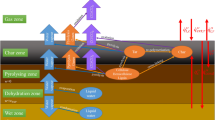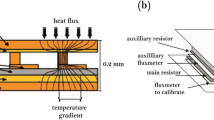Abstract
Moisture induced stress in timber is dependant on many factors. The driving force behind is the moisture variation in the surrounding air which causes induced stress due to restraint of hygro-expansion within timber elements (this can to some extent be seen analogous to thermally induced stress in steel). Today's computational power together with advanced constitutive models offers a valuable tool towards understanding and determining moisture actions on timber. However, it seems that the issue concerning uncertainties of the input parameters is seldom addressed. This paper presents results on how various factors affect the resulting moisture induced stress by a parametric study of the input values. A small numerical change of one parameter may possibly result in a major change of calculated stress levels. It is for example, shown that coating (paint) and cross-sectional dimensions play an important role for spatial stress distribution.
Zusammenfassung
Feuchte induzierte Spannungen im Holz hängen von vielen Faktoren ab. Einen wesentlichen Einfluss haben Feuchteänderungen der umgebenden Luft, die wegen behinderter Feuchtedehnung innerhalb der Holzelemente innere Spannungen verursachen (vergleichbar mit Temperatur induzierten Spannungen im Stahl). Die modernen Hochleistungsrechner und verfeinerten Werkstoffmodelle erlauben, Feuchtevorgänge im Holz besser zu verstehen und zu bestimmen. Es scheint jedoch, dass die Unsicherheit der Eingangsdaten dabei bisher selten berücksichtigt wurde. Mittels einer parametrischen Studie der Eingangswerte werden in der vorliegenden Arbeit Ergebnisse vorgestellt, wie verschiedene Faktoren sich auf Feuchte induzierte Spannungen auswirken. Eine nur geringe numerische Änderung eines Parameters kann zu einer großen Änderung des berechneten Spannungsniveaus führen. So wird unter anderem gezeigt, dass eine Beschichtung (Anstrich) und die Querschnittsabmessungen eine wichtige Rolle bei der räumlichen Spannungsverteilung spielen.






Similar content being viewed by others
References
Armstrong LD, Christensen GN (1961) Influence of moisture changes on deformation of wood under stress. Nature 191:869–870
Gowda S, Kortesmaa M et al. (1998) Duration of load effect on curved glulam beams, part 2: Long term load tests and analysis. ESPOO, VTT Technical Research centre of Finland.
Grossman PUA (1976) Requirements for a model that exhibits mechano-sorptive behaviour. Wood Sci Technol 10:163–168
Häglund M (2007) Moisture content penetration in wood elements under varying boundary conditions. Wood Sci Technol 41:477–490
Häglund M (2008) Varying moisture content and eigen-stresses in timber elements. Wood Mater. Sci. Eng. 1–2: 38–45
Häglund M, Isaksson T, Holst J (2005) Time-series modeling of moisture exposure on timber structures. Build. Environ. 42:1515–1521
Hanhijärvi A (1995) Modelling fo creep deformation mechanisms in wood. Technical Research Centre of Finland, Espoo, Finland, VTT Publications 231
Hanhijärvi A (2000) Advances in the knowledge of the influence of moisture changes on the long-term mechanical performance of timber structures. Mater. Struct. 33:43–49
Hedenblad G (1996) Material data for Moisture Transport Calculations, (in Swedish). T19:1996, ISBN 91-540-5766-3, Swedish Council for Building Research, Stockholm, Sweden
Hukka A (1999) The Effective Diffusion Coefficient and Mass Transfer Coefficient of Nordic Softwoods as Calculated from Direct Drying Experiments. Holzforschung 53(5):534–540
Hunt DG (1999) A unified approach to creep of wood. Proceedings Of The Royal Society Of London Series A-Mathematical Physical And Engineering Sciences 455(1991):4077–4095
Jönsson J (2003) The effect of moisture gradients on tensile strength perpendicular to grain in glulam. Holz Roh- Werkst 61:342–348
Jönsson J (2004) Internal stresses in the cross-grain direction in glulam induced by climate variations. Holzforschung 58:154–159
Jönsson J (2005) Moisture induced stresses in timber structures. Lund Institute of Technology. Doctoral Thesis Report TVBK-1031
Jönsson J, Svensson S (2004) A contact free measurement method to determine internal stress states in glulam. Holzforschung 58:148–153
Kangas J, Ranta-Maunus A (1989) Creep tests on the Finnish pine and spruce perpendicular to the grain, (in Finnish). Technical Research Centre of Finland, Research Notes 969, Espoo
Leicester RH (1971) A rheological model for the mechano-sorptive deflections of beams. Wood Sci Technol 5:211–220
Mårtensson A (1992) Mechanical behaviour of wood exposed to humidity variations. Lund Institute of Technology. Doctoral Thesis Report TVBK-1006
Nevander LE, Elmarsson B (1994) Fukthandboken. (Moisture design manual). 2nd ed. Svensk Byggtjänst, Stockholm, Sweden
Ranta-Maunus A (1973) A theory for the creep of wood with application to birch and spruce plywood. Technical research centre if Finland, Building Technology and community development
Ranta-Maunus A (1975) The viscoelasticity of wood and varying moisture content. Wood Sci Technol 9:189–205
Ranta-Maunus A (1993) Rheological behaviour of wood in directions perpendicular to the grain. Materials and Structures 26:362–369
Ranta-Maunus A, Gowda S (1994) Curved and cambered glulam beams. ESPOO, Technical Research Centre of Finland
Rosenkilde A, Arfvidsson J (1997) Measurement and Evaluation of Moisture Transport Coefficients During Drying of Wood. Holzforschung 51(4):372–380
Svensson S, Toratti T (2002) Mechanical response of wood perpendicular to grain when subjected to changes of humidity. Wood Sci Technol 36:145–156
Svensson S (1997) Internal Stress in Wood Caused by Climate Variations. Lund University. Doctoral Thesis Report TVBK-1013
Thelandersson S, Morén T (1992) Tensile stresses and cracking in drying timber. Department of Structural Engineering, Lund
Toratti T (1992) Creep of timber beams in a variable environment. Helsinki University of Technology, Espoo, Finland. Report 31
Author information
Authors and Affiliations
Corresponding author
Rights and permissions
About this article
Cite this article
Häglund, M. Parameter influence on moisture induced eigen-stresses in timber. Eur. J. Wood Prod. 68, 397–406 (2010). https://doi.org/10.1007/s00107-009-0377-2
Received:
Published:
Issue Date:
DOI: https://doi.org/10.1007/s00107-009-0377-2




